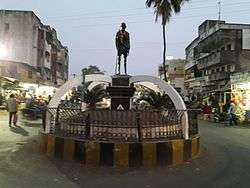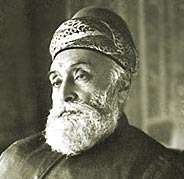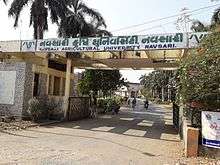Navsari
Navsari (Gujarati: નવસારી) is a city, the ninth biggest municipality of Gujarat and the administrative headquarters Navsari District of Gujarat, India, located between Surat & Mumbai. Navsari is also the Twin City of Surat, and only 30 km south of Surat. In 2016, Navsari ranked as the 16th biggest city of Gujarat state of India by population in 2011. It used to rank 10th in 1991 to 2001. Navsari is the 25th "cleanest city of India" according to the Indian Ministry of Urban Development. Navsari is also a famous place due to the great Satyagraha march led by Mahatma Gandhi till the dandi.
Navsari | |
|---|---|
city | |
 Char Rasta-Eru Circle | |
 Navsari Location in Gujarat, India | |
| Coordinates: 20.95°N 72.93°E | |
| Country | India |
| State | Gujarat |
| District | Navsari |
| Elevation | 9 m (30 ft) |
| Population (2011)[1] | |
| • city | 171,109 |
| • Rank | 16th biggest municipal corporation of Gujarat |
| • Metro | 282,791 |
| Languages | |
| • Official | Gujarati, Hindi, English |
| Time zone | UTC+5:30 (IST) |
| PIN | 396445 |
| Telephone code | 02637 |
| Vehicle registration | GJ-21 |
History

Navsari was originally known as "Navasarika", and was the capital of a vishya (an administrative unit) in the Lata region.[2][3] It is identified with "Nusaripa", a city mentioned in Ptolemy's 2nd century Greek-language work Geography.[4]
The Chalukyas of Navasarika, who governed the area around Navsari as subordinates of the Chalukyas of Vatapi, repulsed an Umayyad invasion of the area in 738-739 CE.[5]
Two families of Parsi Zoroastrian priests settled in Navsari in the early 13th century, and the town soon emerged as the major centre of the Parsi priesthood and religious authority. As Parsi community grow at other places in India, the priests from Navsari were sought by the new Parsi settlements. Surat replaced Navsari as the principal settlement of the Parsi community in the 18th century, following its rise as a major trade centre for the European factories, and the Maratha incursions into Navsari; Surat itself lost this position to Bombay in the later years.[6]
Geography
Navsari is located at 20.95°N 72.93°E. It has an average elevation of 9m (29') above sea level. The city is located in southern Gujarat and is situated near the Purna River, within a few kilometers of the river's delta, which is west of the city and empties into the Gulf of Khambhat. The weather in Navsari is sunny from October to May, and rainy from June to September. The average maximum and minimum temperatures are 40 °C (104 °F) and 17 °C (62.6 °F) respectively. The average annual rainfall is 122 cm (48 in).
Demographics
The city's first settlers were the Chalukyas, followed by the Rashtrakutas, and subsequent settlements by the Parsis.
According to the 2011 census,[1][7] Navsari had a population of 171,109. Males constituted 52% of the population and females 48%. Navsari had an average literacy rate of 88%, higher than the national average of 74%: male literacy was 92%, and female literacy was 84%. 10% of the population was under 6 years of age.
Gujarati is the main language spoken in Navsari. The other languages spoken are Hindi and Marathi.
Landmarks
The Sayaji Vaibhav Public Library Navsari is an important public building in Navsari.
The Meherjirana library.
This is one of the oldest libraries in South Gujarat Region. It was established by the first Dastur (Parsi/Zoroastrian priest) Meherjirana, who was also born in Navsari. He was invited by Akbar in a religious programme organized by the Great Akbar. Leaders of all religious groups participated in it. Akbar asked to start a conversation and eventually asked to give information about their religion. All the religious leaders gave information about their religions and gradually tried to show their religions as great except Dastur Meherjirana. Afterward, the leaders asked Akbar his opinion as to whose religion is great. Akbar was really impressed by Dastur Meherjirana, so he asked him. Meherjirana Dastur calmly replied, "All religions are equal in terms of strength and ideology and principle". Akbar was extremely impressed by his personality. He donated a piece of land to Dastur Meherjirana in Navsari, where today The Meherjirana Library stands. Akbar wrote on a scroll about the donation of land which is still preserved by the management of the library.
The Dandi seashore is an important location from the point of view of India's Independence Movement. In 1930 Mahatma Gandhi started the "Dandi March" from Sabarmati Ashram up to the Dandi seashore to protest against a tax on salt by the colonial government.
Ajmalgadh
Though it is surrounded by high hills, this is a historical place. Zoroastrians/Parsis roamed in the forest and cave of Ajmalgadh to save and protect their sacred fire-cauldron for nearly 250–350 years. Recently, local administration constructed a pillar on the hill of Ajmalgadh describing the story. They also closed the cave which was used to protect the holy fire.
Transportation
The nearest domestic and international airport is at Surat International Airport at Magdalla, Surat, 48 km.
Navsari also lies on the Mumbai-Delhi railway link, one of the busiest railway routes in India.
Navsari is well connected by NH 228 also known as Sabarmati-Dandi Highway. NH 48 also passes through the city. Navsari is only 30 km south of Surat.
Education

Universities and colleges
Engineering Universities and colleges
Arts & Commerce Universities and colleges
- Sorabji Burjorji Garda Arts College
- B.P. Baria Science College
- Navsari Agricultural University
- P.K. Patel Commerce College
- Navsari Law College
- Vallabhbudhi Polytechnic, Navsari
- Arts And Commerce College, Chovisi (Dist:Navsari)
- Naranlala College of Professional and Applied Science
- S.S. Agrawal College of Arts, Commerce and Management, Navsari
- S.S. Agrawal College of Nursing Training College and Research Centre, Navsari
- S.S. Agrawal Institute of Management and Technology, Navsari
- S.S. Agrawal Homeyopathic Collage, Navsari
- B.D. Gohil, Navsari.
- Dinshaw Daboo Law College
- District Institute of Education and Training, Navsari - B. Ed. College
Schools
- Sheth H.C. Parekh, Navsari High School
- Tapovan SanskarDham Vidhyalaya
- Bai Navajbai Tata Zoroastrian Girls School
- The Vidyakunj High School
- Seth P.H. Vidyalaya (Sanskarbharti)
- Akhil Hind Mahila Parishad High School
- Bai Navajbai Tata Girls' High School
- Seth R.J.J. High School
- Sir Jamshetji Jeejeebhoy English medium high school
- The Navsari High School
- Real English School[10]
- St. Francis of Assisi Convent High School
- Bhakta Ashram
- Seventh-Day Adventist English School
- Dadabhau Kawasji Tata High School
- Dinbai Daboo Girls High School
- Sir Cowasjee Jehangir Nauserwanjee Zarthosjee Madresa High School
- Late G.C Patel Vidhyalaya
- SGM Shiroiya School
- R.D Patel Sarvajanik High School
- Mamta Mandir
- Seth Banatwala High School
- Shree Sardar Patel Vidhya Bhavan, Jalalpore
- Aster Global School,Navsari
- Shree Sardar Sharda Mandir, Vijalpore
- Seema Patel Higher Secondary School
- A.B. Higher Secondary School
- Hemali English Primary & Modern English Secondary & Higher Secondary School
- Naranlala Higher Secondary School
- Divine Public School
- Raman Brothers Vidyalaya, Ugat
- Sri Sathya Sai Vidyaniketan, Ganeshvad Sisodra
- New English Marathi Madyamik School,Vijalpur
Hospitals
- The Dorabji Nanabhoy Mehta Sarvajanik Hospital
- K.D.N. Gohil Hospital[11]
- Daboo Hospital
- Rotary Eye Institute[12]
- Orange Hospital
- Yashfin Hospital
- Mulla Hospital
- Civil Hospital
- Kejal Hospital
- Dhruvini Nursing Home & Iccu
- Mulla Hospital
- Ramaben Hospital
- Lions Hospital
- Shraddha Hospital
- Shushrusha Hospital
- Anand Hospital
- Parmar Hospital
Notable people
- Jeetan Patel (1980), New - Zealand international Cricketer of Indian Origin.
- Homai Vyarawalla (1913–2012), first woman photojournalist of India, Padma Vibushan[13]
- Ram Ganesh Gadkari (1885 - 1919), Marathi poet, playwright, and humorist
- Jamsetjee Jejeebhoy, merchant and philanthropist
- Meherji Rana, spiritual leader of the Parsi community in India
- Jamsetji Tata, founder of what would later become the Tata Group of companies, regarded as the "father of Indian industry"
- Dadabhai Naoroji, known as the "Grand Old Man of India", Member of Parliament (MP) in the House of Commons of the United Kingdom between 1892 and 1895
References
- "Navsari City Population Census 2011 | Gujarat". www.censusindia.co.in. Retrieved 31 March 2018.
- Dilip K. Chakrabarti (2003). The Archaeology of European Expansion in India: Gujarat, c. 16th-18th Centuries. Aryan Books. p. 82. ISBN 978-81-7305-250-7.
- D.C. Sircar (2008). Studies in Indian Coins. Motilal Banarsidass. p. 116. ISBN 978-81-208-2973-2.
- Jairus Banaji (2015). "'Regions that Look Seaward': Changing Fortunes, Submerged Histories, and the Slow Capitalism of the Sea". In Federico De Romanis; Marco Maiuro (eds.). Across the Ocean: Nine Essays on Indo-Mediterranean Trade. BRILL. p. 117. ISBN 978-90-04-28953-6.
- K. Y. Blankinship (1994). The End of the Jihad State: The Reign of Hisham Ibn 'Abd al-Malik and the Collapse of the Umayyads. State University of New York Press. p. 187. ISBN 9780791418284. Retrieved 17 October 2014.
- Jesse S. Palsetia (2001). The Parsis of India: Preservation of Identity in Bombay City. BRILL. p. 10. ISBN 90-04-12114-5.
- "Navsari Population, Caste Data Navsari Gujarat - Census India". www.censusindia.co.in. Retrieved 31 March 2018.
- Mahatma Gandhi Inst. of Technical Education and Research
- http://gdec.in/
- Real English School
- K.D.N. Gohil Hospital
- Rotary Eye Institute
- "Homai gets Padma Vibhushan". The Times of India. 25 January 2011.